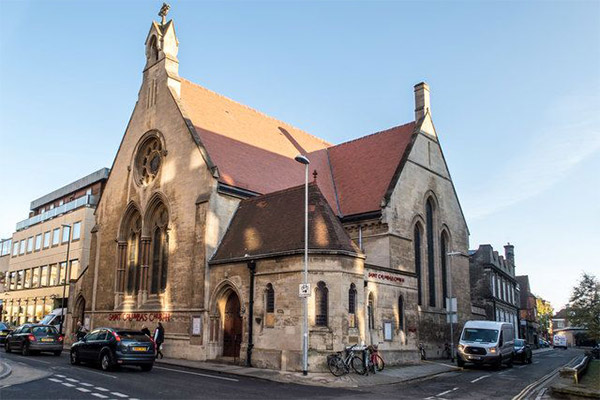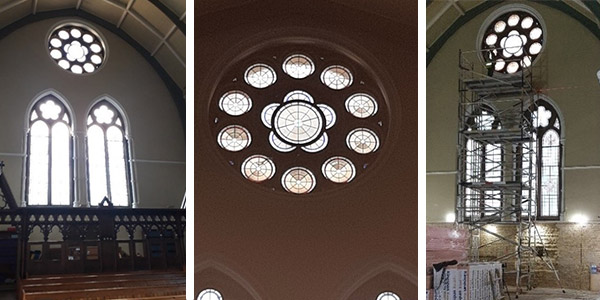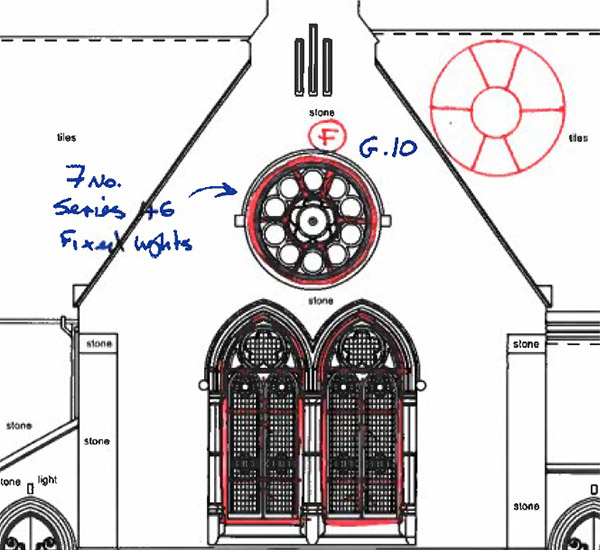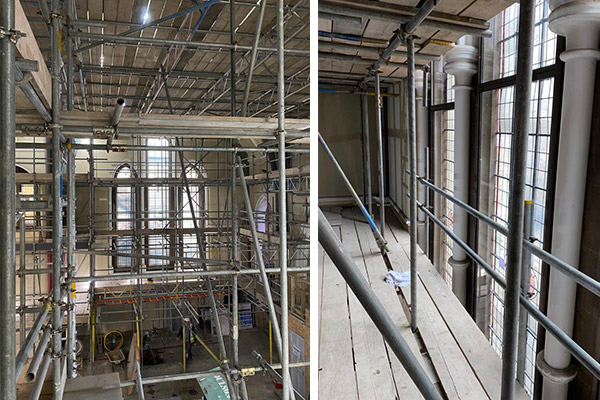On a lot of Church projects, we recommend openable secondary units for the purpose of ventilation, cleaning and maintenance as dirt and grime can get into the cavity between the primary and secondary windows. However, assessing the client needs is vital when choosing the right secondary glazing solution. Any window can have multiple treatment options, but to choose what to go ahead with is as much down to the customer's needs as to what we recommend. This was the case during a recent installation at the Downing Place United Reform Church in Cambridge.
 Exterior of Downing Place United Reform Church – Image credit: Pinterest
Historic church windows are generally large and made from single layers of glass. This means that they are relatively poor at keeping in heat, tending to generate cold down draughts in the winter. The use of secondary glazing allows the original windows to be retained, whilst reducing air leakage and conducted heat losses. The bespoke units are designed to reflect the lines of the original windows, including gothic arched, curved, round and curved on plan. As a result, there is no loss of historic features and the installation is reversible. To help improve the thermal integrity of the primary windows, secondary was chosen as the ideal solution on this church project despite the building not having a Listing.
Series 46 fixed light secondary glazing was the preferred system for the much larger windows in the Nave section of the Church, ensuring that the framing sections and interlocks are kept as thin as possible. This was because there was no requirement for the secondary glazing to open in the Nave as natural ventilation would be acquired through the opening of newly installed roof lights. Furthermore, the Church would not clean the primary stained-glass windows regularly, so they were not opposed to removing the panels, cleaning, and reinstalling them on the rare occasion.
The large circular primary window in the Nave posed a particular challenge due to its shape and elevated position. As with any curved window, our surveyors use a laser measurer to plot the opening. This is the only way to guarantee optimal fitting tolerances for installation, maximising the required benefits. The biggest challenge with this circular window was the height of the cill, both at survey and install stage. An arrangement was made by the main contractor to build a scaffolding tower so that our in-house surveyor could take accurate dimensions. Getting as close to the ocular window was paramount to guarantee there was no 'creep' in measurements. Our surveyor had to remain absolutely still whilst operating the laser measure atop the tower with another member of the team on a platform below double guiding and checking the laser pointer position.
Exterior of Downing Place United Reform Church – Image credit: Pinterest
Historic church windows are generally large and made from single layers of glass. This means that they are relatively poor at keeping in heat, tending to generate cold down draughts in the winter. The use of secondary glazing allows the original windows to be retained, whilst reducing air leakage and conducted heat losses. The bespoke units are designed to reflect the lines of the original windows, including gothic arched, curved, round and curved on plan. As a result, there is no loss of historic features and the installation is reversible. To help improve the thermal integrity of the primary windows, secondary was chosen as the ideal solution on this church project despite the building not having a Listing.
Series 46 fixed light secondary glazing was the preferred system for the much larger windows in the Nave section of the Church, ensuring that the framing sections and interlocks are kept as thin as possible. This was because there was no requirement for the secondary glazing to open in the Nave as natural ventilation would be acquired through the opening of newly installed roof lights. Furthermore, the Church would not clean the primary stained-glass windows regularly, so they were not opposed to removing the panels, cleaning, and reinstalling them on the rare occasion.
The large circular primary window in the Nave posed a particular challenge due to its shape and elevated position. As with any curved window, our surveyors use a laser measurer to plot the opening. This is the only way to guarantee optimal fitting tolerances for installation, maximising the required benefits. The biggest challenge with this circular window was the height of the cill, both at survey and install stage. An arrangement was made by the main contractor to build a scaffolding tower so that our in-house surveyor could take accurate dimensions. Getting as close to the ocular window was paramount to guarantee there was no 'creep' in measurements. Our surveyor had to remain absolutely still whilst operating the laser measure atop the tower with another member of the team on a platform below double guiding and checking the laser pointer position.
 Erected scaffolding to facilitate the measuring of the large circular window in the Nave
A proven method of fixing was used for this secondary glazing treatment. Having previously worked on a similarly large circular window in the past, a timber mullioned cartwheel frame was crafted to securely hold the secondary glazing. Each element of the rose window was initially created in CAD format from the laser measurements. Scaled trace sheets were then produced to provide both the timber shop and factory with the exact dimensions for each element. The timber subframes were built in segments with each mullion split to be screwed together within the window opening during installation. These sections would form the cartwheel frame. Seven bespoke Series 46 Fixed Light segments were made for it and glazed with 6mm toughened glass, which was used to give additional rigidity and structural strength.
Erected scaffolding to facilitate the measuring of the large circular window in the Nave
A proven method of fixing was used for this secondary glazing treatment. Having previously worked on a similarly large circular window in the past, a timber mullioned cartwheel frame was crafted to securely hold the secondary glazing. Each element of the rose window was initially created in CAD format from the laser measurements. Scaled trace sheets were then produced to provide both the timber shop and factory with the exact dimensions for each element. The timber subframes were built in segments with each mullion split to be screwed together within the window opening during installation. These sections would form the cartwheel frame. Seven bespoke Series 46 Fixed Light segments were made for it and glazed with 6mm toughened glass, which was used to give additional rigidity and structural strength.
 Drawing depicting circular window and proposed timber wheel mullion to accommodate Series 46 fixed lights
During the installation phase, scaffolding was erected to ensure full access to all of the window openings. The installation team reached the circular window via the top level, which was boarded out to cover the whole Nave area from one end to the other. Before the units were fixed in position, the installers carried out a thorough clean and inspection of the primary window. Each fixed light segment and timber frame had to be passed up by hand through the scaffold. The timber frame was then assembled on the platform in front of the opening and then fixed in position. Finally, each fixed light was secured to complete the works. Despite limited lighting and a lot of dust, the installation was a great success.
Drawing depicting circular window and proposed timber wheel mullion to accommodate Series 46 fixed lights
During the installation phase, scaffolding was erected to ensure full access to all of the window openings. The installation team reached the circular window via the top level, which was boarded out to cover the whole Nave area from one end to the other. Before the units were fixed in position, the installers carried out a thorough clean and inspection of the primary window. Each fixed light segment and timber frame had to be passed up by hand through the scaffold. The timber frame was then assembled on the platform in front of the opening and then fixed in position. Finally, each fixed light was secured to complete the works. Despite limited lighting and a lot of dust, the installation was a great success.
 The network of scaffolding throughout the church
Selectaglaze has installed complex treatments like this in a number of churches across the UK, remaining sympathetic to the stained glass, leaded and window tracery, whilst significantly enhancing energy efficiency of the windows with minimal visual impact.
The network of scaffolding throughout the church
Selectaglaze has installed complex treatments like this in a number of churches across the UK, remaining sympathetic to the stained glass, leaded and window tracery, whilst significantly enhancing energy efficiency of the windows with minimal visual impact.
 Exterior of Downing Place United Reform Church – Image credit: Pinterest
Historic church windows are generally large and made from single layers of glass. This means that they are relatively poor at keeping in heat, tending to generate cold down draughts in the winter. The use of secondary glazing allows the original windows to be retained, whilst reducing air leakage and conducted heat losses. The bespoke units are designed to reflect the lines of the original windows, including gothic arched, curved, round and curved on plan. As a result, there is no loss of historic features and the installation is reversible. To help improve the thermal integrity of the primary windows, secondary was chosen as the ideal solution on this church project despite the building not having a Listing.
Series 46 fixed light secondary glazing was the preferred system for the much larger windows in the Nave section of the Church, ensuring that the framing sections and interlocks are kept as thin as possible. This was because there was no requirement for the secondary glazing to open in the Nave as natural ventilation would be acquired through the opening of newly installed roof lights. Furthermore, the Church would not clean the primary stained-glass windows regularly, so they were not opposed to removing the panels, cleaning, and reinstalling them on the rare occasion.
The large circular primary window in the Nave posed a particular challenge due to its shape and elevated position. As with any curved window, our surveyors use a laser measurer to plot the opening. This is the only way to guarantee optimal fitting tolerances for installation, maximising the required benefits. The biggest challenge with this circular window was the height of the cill, both at survey and install stage. An arrangement was made by the main contractor to build a scaffolding tower so that our in-house surveyor could take accurate dimensions. Getting as close to the ocular window was paramount to guarantee there was no 'creep' in measurements. Our surveyor had to remain absolutely still whilst operating the laser measure atop the tower with another member of the team on a platform below double guiding and checking the laser pointer position.
Exterior of Downing Place United Reform Church – Image credit: Pinterest
Historic church windows are generally large and made from single layers of glass. This means that they are relatively poor at keeping in heat, tending to generate cold down draughts in the winter. The use of secondary glazing allows the original windows to be retained, whilst reducing air leakage and conducted heat losses. The bespoke units are designed to reflect the lines of the original windows, including gothic arched, curved, round and curved on plan. As a result, there is no loss of historic features and the installation is reversible. To help improve the thermal integrity of the primary windows, secondary was chosen as the ideal solution on this church project despite the building not having a Listing.
Series 46 fixed light secondary glazing was the preferred system for the much larger windows in the Nave section of the Church, ensuring that the framing sections and interlocks are kept as thin as possible. This was because there was no requirement for the secondary glazing to open in the Nave as natural ventilation would be acquired through the opening of newly installed roof lights. Furthermore, the Church would not clean the primary stained-glass windows regularly, so they were not opposed to removing the panels, cleaning, and reinstalling them on the rare occasion.
The large circular primary window in the Nave posed a particular challenge due to its shape and elevated position. As with any curved window, our surveyors use a laser measurer to plot the opening. This is the only way to guarantee optimal fitting tolerances for installation, maximising the required benefits. The biggest challenge with this circular window was the height of the cill, both at survey and install stage. An arrangement was made by the main contractor to build a scaffolding tower so that our in-house surveyor could take accurate dimensions. Getting as close to the ocular window was paramount to guarantee there was no 'creep' in measurements. Our surveyor had to remain absolutely still whilst operating the laser measure atop the tower with another member of the team on a platform below double guiding and checking the laser pointer position.
 Erected scaffolding to facilitate the measuring of the large circular window in the Nave
A proven method of fixing was used for this secondary glazing treatment. Having previously worked on a similarly large circular window in the past, a timber mullioned cartwheel frame was crafted to securely hold the secondary glazing. Each element of the rose window was initially created in CAD format from the laser measurements. Scaled trace sheets were then produced to provide both the timber shop and factory with the exact dimensions for each element. The timber subframes were built in segments with each mullion split to be screwed together within the window opening during installation. These sections would form the cartwheel frame. Seven bespoke Series 46 Fixed Light segments were made for it and glazed with 6mm toughened glass, which was used to give additional rigidity and structural strength.
Erected scaffolding to facilitate the measuring of the large circular window in the Nave
A proven method of fixing was used for this secondary glazing treatment. Having previously worked on a similarly large circular window in the past, a timber mullioned cartwheel frame was crafted to securely hold the secondary glazing. Each element of the rose window was initially created in CAD format from the laser measurements. Scaled trace sheets were then produced to provide both the timber shop and factory with the exact dimensions for each element. The timber subframes were built in segments with each mullion split to be screwed together within the window opening during installation. These sections would form the cartwheel frame. Seven bespoke Series 46 Fixed Light segments were made for it and glazed with 6mm toughened glass, which was used to give additional rigidity and structural strength.
 Drawing depicting circular window and proposed timber wheel mullion to accommodate Series 46 fixed lights
During the installation phase, scaffolding was erected to ensure full access to all of the window openings. The installation team reached the circular window via the top level, which was boarded out to cover the whole Nave area from one end to the other. Before the units were fixed in position, the installers carried out a thorough clean and inspection of the primary window. Each fixed light segment and timber frame had to be passed up by hand through the scaffold. The timber frame was then assembled on the platform in front of the opening and then fixed in position. Finally, each fixed light was secured to complete the works. Despite limited lighting and a lot of dust, the installation was a great success.
Drawing depicting circular window and proposed timber wheel mullion to accommodate Series 46 fixed lights
During the installation phase, scaffolding was erected to ensure full access to all of the window openings. The installation team reached the circular window via the top level, which was boarded out to cover the whole Nave area from one end to the other. Before the units were fixed in position, the installers carried out a thorough clean and inspection of the primary window. Each fixed light segment and timber frame had to be passed up by hand through the scaffold. The timber frame was then assembled on the platform in front of the opening and then fixed in position. Finally, each fixed light was secured to complete the works. Despite limited lighting and a lot of dust, the installation was a great success.
 The network of scaffolding throughout the church
Selectaglaze has installed complex treatments like this in a number of churches across the UK, remaining sympathetic to the stained glass, leaded and window tracery, whilst significantly enhancing energy efficiency of the windows with minimal visual impact.
The network of scaffolding throughout the church
Selectaglaze has installed complex treatments like this in a number of churches across the UK, remaining sympathetic to the stained glass, leaded and window tracery, whilst significantly enhancing energy efficiency of the windows with minimal visual impact.- Date
- Category
- Treat Of The Month